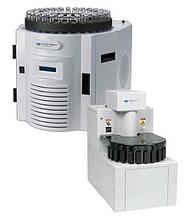 In the first part of our series on headspace analysis, we covered the basics, from defining what it is and how it saves labs time and money to its uses in modern labs. In part two, we detailed how analysts can achieve the best performances using headspace/gas chromatography (GC) and the importance of correctly preparing samples for analysis. In the third part, we will focus on the three common techniques that are used to transfer a headspace sample from the vials to the GC. These include gas-tight syringe injection, balanced-pressure systems and pressure-loop systems.
In the first part of our series on headspace analysis, we covered the basics, from defining what it is and how it saves labs time and money to its uses in modern labs. In part two, we detailed how analysts can achieve the best performances using headspace/gas chromatography (GC) and the importance of correctly preparing samples for analysis. In the third part, we will focus on the three common techniques that are used to transfer a headspace sample from the vials to the GC. These include gas-tight syringe injection, balanced-pressure systems and pressure-loop systems.
Gas-Tight Syringe Injection
In this technique, the analyst waits until the sample has reached equilibrium after sitting in an incubation oven at a specific temperature and for a specific period of time. An aliquot is then taken from the headspace using the gas-tight syringe, and then injected in the GC similar to a liquid sample.
While this technique is fairly simple to use, there are several concerns for gas-tight syringe injection, which has led some manufacturers to make modifications to their samplers. Among the principle concerns is that the sample is usually transferred from a heated oven using a non-heated syringe. Unless the syringe is also heated, there is a possibility that the sample could recondense inside the instrument. This has led some manufacturers to add a heated syringe assembly to their samplers. There are also additional concerns about sample loss due to pressure conditions differences between the contained environment within the vial and the atmospheric conditions outside the vial. Despite these concerns, gas-tight syringe injection can retrofit into any GC system and is suited for diverse samples, which makes it a commonly used transfer technique.
Balanced-Pressure System
This technique is used because it has a minimal number of moving parts, making it highly reproducible while decreasing the possibility of compound absorption and leaks. The process uses a seamless injection taken directly from the vial into the carrier gas stream. Other than a valve and needle there are no other moving parts required. Similar to the gas-tight syringe injection system, an incubation oven is used to help the sample reach equilibrium. Initially, a needle is inserted into the vial and then pressurized with a carrier gas. Once equilibrium is reached, the valve is switched for a specific amount of time, redirecting the sample into the transfer line and onto the column. A concern for this technique is that the absolute volume of the sample is unknown because the system uses a theoretical amount of time to inject the sample. Any concerns are offset by the fact that the technique is highly repeatable.
Pressure-Loop System
The pressure-loop system uses a known sample volume, and typically employs a six-port valve. The vial is initially pressurized and thermostated in the same way as other systems, and following pressurization, the valve is turned and the pressure-loop is filled. Once the loop is filled, the valve is turned again and the gas is redirected, flushing the sample into the transfer line.
There are key advantages and disadvantages to the pressure-loop system. The loop can be heated to high temperatures, which lessens absorption of higher molecule weight and sensitive compounds. And like the pressure-loop system, the fixed sample volume makes the process reproducible. A key disadvantage of this system is the possibility of sample carryover from previous analysis, which could cause ghost peaks.
“Key issues to address when setting up headspace/GC systems include minimizing system dead volume, maintaining intert sample flow paths, and achieving efficient sample transfer.”[i]
Like sample preparation, selecting the right instrumentation and techniques is critical to preventing any of these issues. The transfer methods listed above involve only a few of the components used during the headspace process. Others things to consider that may impact the quality of the analysis are the transfer line, including its diameter and temperature; and the injection port interface, which connects the transfer line to the analytical column.
Teledyne Tekmar draws on our experience as a leader in low-level VOC analysis with the HT3 and the Versa Static and Dynamic Headspace Systems.
Versa is the perfect solution for applications which require all the advantages of headspace analysis and is economical to fit any budget. Click for more information on the Versa.
Dramatic improvements in sensitivity are achieved with the HT3 Dynamic Headspace option, while maintaining the ruggedness and reliability of a traditional Static Headspace instrument. Click for more information on the HT3.
[i] Restek, Inc. “A Technical Guide for Static Headspace Analysis Using GC,” pg. 3
